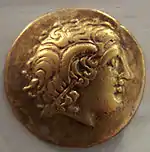Veragri
The Veragri (Gaulish: Ueragri, 'super-warriors'; Greek: Οὐάραγροι) were a Gallic tribe dwelling in the Pennine Alps during the Iron Age and the Roman period.
Along with the Nantuates, Seduni and Uberi, they were part of the Vallenses, a group of tribes living between the Lake Geneva and the Pennine Alps, in the modern canton of Valais (Switzerland).[1]
Name
They are mentioned as Veragros by Caesar (mid-1st c. BC),[2] Sed uno uer agri (perhaps for Seduni and Veragri) by Livy (late 1st c. BC),[3] Ou̓áragroi (Οὐάραγροι) by Strabo (early 1st c. AD),[4] Varagri by Pliny (1st c. AD),[5] Ouarágrous (Οὐαράγρους) by Cassius Dio (3rd c. AD),[6] and as Veragros (var. beragros, ueragres) by Orosius (early 5th c. AD).[7][8]
The Gaulish ethnonym Ueragri (sing. Ueragros) has been translated as 'super-warriors'. It stems from the Celtic root uer(o)- ('super'; OIr. for-, Old Welsh guar; from PIE *uper-) attached to agro- ('battle, carnage'; OIr. ár, OBret. air; from PIE *h₂eǵro- 'hunt').[9] Christian-Joseph Guyonvarc'h has also proposed to interpret the name as 'great hunters'.[8]
Geography
The Veragri dwelled in the Pennine Alps, on the route from Gaul and Rhaetia into the Italian Peninsula, where they organized traffic over the Great St Bernard pass.[10] They were located south of the Nantuates, west of the Seduni and Uberi, northeast of the Allobroges, and north of the Salassi, on the other side of the Alps.[11][10] After the Roman conquest in 16–15 BC, their territory was initially administered in common with Raetia et Vindelicia under a legatus, then integrated into the Alpes Graiae et Poeninae by Claudius (41–54 AD), whose procurator had an occasional residence in their chief town.[1]
Their chief town was Octodurus (modern Martigny), whence the Veragri were called Octodurenses by Pliny.[10][8] Mentioned by Caesar, the settlement was a vicus (village) located in the plain of Martigny, at the foot of the Great St Bernard Pass.[12] Between 41 and 47 AD, the Romans founded the city of Forum Claudii Augusti (quickly renamed Forum Claudii Vallensium), near Octodurus.[12] The new city became the chief town of Alpes Poeninae, one of the two divisions of the province of Alpes Graiae et Poeninae. During the Late Roman Empire, the name Octodurus, which had never ceased to be used by the locals, came to designate the settlement in official documents. Between 549 and 585, the city was outshined by Sion.[13]
History
The Veragri were attacked by Caesar's legate Sulpicius Galba at the Battle of Octodurus in 57 BC.[10]
During the same period Servius Galba, who was serving as his lieutenant, had, while the season lasted and his army remained a unit, brought to terms the Veragri, who dwelt along Lake Leman and beside the Allobroges as far as the Alps; some he had gained by force and others through surrender, and he was even preparing to winter where he was. When, however, the majority of the soldiers had departed, some on furlough because they were not far from Italy, and others elsewhere for reasons of their own, the natives took advantage of this situation and unexpectedly attacked him. Then Galba, driven mad by despair, suddenly dashed out of the winter camp, astounding his besiegers by the incredible boldness of his move, and passing through them, gained the heights. On reaching safety he fought them off and later subjugated them.
The territory of the Vallenses was occupied by the Roman forces of Augustus after the Alpine campaign of 16–15 BC.[1]
References
- Graßl 2006b.
- Caesar. Commentarii de Bello Gallico, 3:1, 3:2.
- Livy. Ab Urbe Condita Libri, 2:38:8.
- Strabo. Geōgraphiká, 4:6:6.
- Pliny. Naturalis Historia, 3:137.
- Cassius Dio. Rhōmaïkḕ Historía, 39:5:2.
- Orosius. Historiae Adversus Paganos, 6:8:1.
- Falileyev 2010, s.v. Veragri and Octodurus.
- Delamarre 2003, p. 35, 314.
- Graßl 2006a.
- Talbert 2000, Map 17 Lugdunum, Map 18 Augustonemetum-Vindonissa.
- Wiblé 2004, p. 453.
- Wiblé 2004, p. 451.
Primary sources
- Caesar (1917). The Gallic War. Loeb Classical Library. Translated by Edwards, H. J. Harvard University Press. ISBN 978-0-674-99080-7.
- Cassius Dio (1914). Roman History. Loeb Classical Library. Translated by Cary, Earnest; Foster, Herbert B. Harvard University Press. ISBN 978-0-674-99041-8.
- Livy (2019). History of Rome. Loeb Classical Library. Translated by Yardley, J. C. Harvard University Press. ISBN 978-0674992566.
- Pliny (1938). Natural History. Loeb Classical Library. Translated by Rackham, H. Harvard University Press. ISBN 9780674993648.
Bibliography
- Delamarre, Xavier (2003). Dictionnaire de la langue gauloise: Une approche linguistique du vieux-celtique continental. Errance. ISBN 9782877723695.
- Falileyev, Alexander (2010). Dictionary of Continental Celtic Place-names: A Celtic Companion to the Barrington Atlas of the Greek and Roman World. CMCS. ISBN 978-0955718236.
- Graßl, Herbert (2006a). "Veragri". Brill’s New Pauly. doi:10.1163/1574-9347_bnp_e12200510.
- Graßl, Herbert (2006b). "Vallenses". Brill’s New Pauly. doi:10.1163/1574-9347_bnp_e1228280.
- Talbert, Richard J. A. (2000). Barrington Atlas of the Greek and Roman World. Princeton University Press. ISBN 978-0691031699.
- Wiblé, François (2004). "Martigny / Octodurus (Suisse)". Supplément à la Revue archéologique du centre de la France. 25 (1): 451–456. ISSN 1951-6207.
